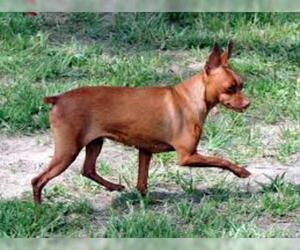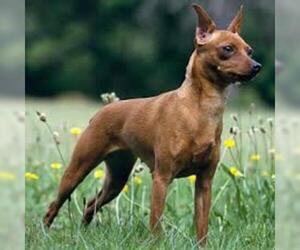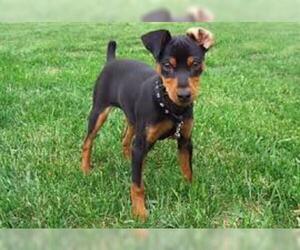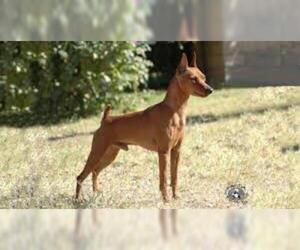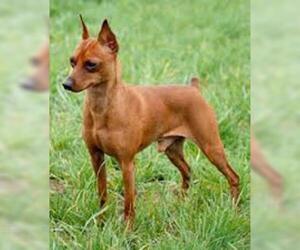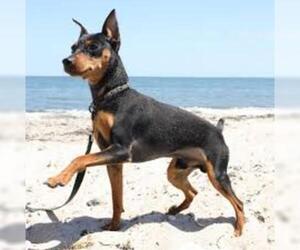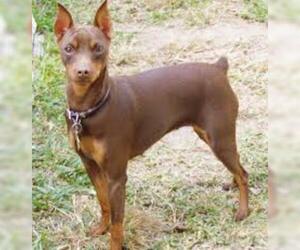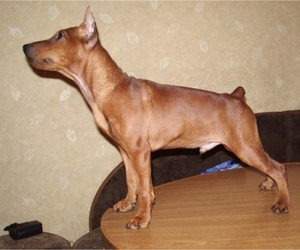
All about Miniature Pinscher dog breed
A.K.A. :Min Pin, Zwergpinscher, Reh Pinscher, Teacup Miniature Pinscher, Toy Miniature Pinscher, Mini Pinscher
Size
Grooming requirements
Exercise requirements
Good with other dogs
Watchdog ability
Energetic
Training requirements
Playful
Affectionate
Good with other pets
Good with children
Good with strangers
Winter
Summer
Healthiness
Protective
Life Span
| Pure Breeds | Member |
| Breeds A - Z | M |
| Breeds by Group | Companion Toy |
| Breeds by Trait | Fast Dog Breeds High Stamina Dog Breeds |
| Overview: | The Miniature Pinscher, often affectionately called "Min Pin," is a small, elegant breed originating from Germany, where it was bred to hunt vermin. Despite its resemblance to a small Doberman, the two breeds are distinct. Physically, Min Pins are characterized by their sleek, short coats, typically black, red, or chocolate with rust markings, and their alert, high-stepping gait, earning them the nickname "King of Toys." They possess a confident, curious, and often bold temperament, embodying a big dog personality in a compact package. While they are energetic and require regular exercise, their small size makes them well-suited for apartment living, provided they receive adequate mental and physical stimulation. They can be good family pets, especially with older children who understand how to interact with a smaller, more delicate dog. Prospective owners should be aware of potential health issues such as patellar luxation and progressive retinal atrophy. Overall, the Min Pin is a lively, intelligent companion for those seeking an active and spirited small dog. |
F.A.Q.
All You Need to Know About the Miniature Pinscher Breed
The Miniature Pinscher, often called a "Min Pin," is a vibrant and self-assured breed originating from Germany, where they were initially bred to hunt vermin. These Miniature Pinscher dogs boast a unique "King of Toys" temperament—bold, curious, and energetic, despite their small size. Physically, they are sleek and muscular, with a short, smooth coat typically in red, black and rust, or chocolate and rust. Min Pins are intelligent and loyal, making them excellent companions for active individuals or families with older children, but their independent streak requires consistent training. They adapt well to apartment living provided they receive adequate daily exercise and mental stimulation. Their short coat is low-maintenance, requiring minimal grooming, but they do feel the cold. Common health considerations for the Miniature Pinscher include patellar luxation and progressive retinal atrophy. If you're seeking a spirited, devoted, and relatively low-grooming dog, the Miniature Pinscher could be your perfect match!The average weight of a Miniature Pinscher is between 8-10 pounds. This is the healthy adult weight for this breed. While both males and females typically fall within this range, some individual variation can occur, with some slightly smaller or larger within the breed standard. When looking for a Miniature Pinscher, understanding their typical size helps ensure you find a healthy and happy companion.
Curious about the Miniature Pinscher height and how tall they typically get? When considering a Min Pin, understanding their average size is key!
The average height of a Miniature Pinscher, measured at the shoulder (from the ground to the highest point of their shoulder blades), is generally between 10 to 12.5 inches (25.4 to 31.75 cm). This range encompasses most healthy adult Miniature Pinschers.While this is the standard expectation for how tall is a Miniature Pinscher, you might observe slight variations. Gender doesn't typically play a significant role in their overall height, with both males and females generally falling within this same range. However, individual genetics can lead to some pups being a little shorter or slightly taller within a few inches of the standard, even within the same litter.So, when you're looking for a Min Pin, expect a compact yet sturdy companion standing proudly around 10 to 12.5 inches at the shoulder!The Miniature Pinscher colors primarily recognized by the AKC are red, stag red, black with rust markings, and chocolate with rust markings. Red can range from a light reddish-brown to a deep mahogany. Stag red refers to a red coat with black hairs interspersed, often on the back or tail.While these are the AKC recognized Miniature Pinscher colors, you may occasionally encounter rare coat types or exotic Miniature Pinscher variations. These include blue (a dilute black), lilac (a dilute chocolate), and fawn (a dilute red), all of which are not accepted by major kennel clubs like the AKC. Other unaccepted variations, often resulting from irresponsible breeding practices, can include merle or white patterns. When searching for Miniature Pinscher colors, be aware that non-standard colors may indicate a less reputable breeder and potential health issues. Pricing for rare colors may be higher due to their novelty, but buyers should prioritize health and temperament over an unaccepted coat color.
Miniature Pinscher Personality & TemperamentThe Miniature Pinscher, often called the "King of Toys," boasts a bold and energetic temperament of Miniature Pinscher. Despite their small size, they have a big personality, characterized by confidence and fearlessness. They are generally loyal and affectionate with their families, forming strong bonds. While typically friendly with familiar faces, they can be reserved with strangers and possess a strong watchdog instinct, often alerting their owners to anything unusual with a surprisingly loud bark.Their sociability with other dogs can vary; early socialization is crucial. With proper introductions, they can coexist peacefully, but their assertive nature means they might try to dominate larger dogs. When it comes to children, Miniature Pinschers can be good companions for older, respectful children who understand how to interact with a small dog. Their feisty nature and small size mean they may not tolerate rough play from very young children.The Miniature Pinscher is an intelligent and adaptable breed. Their moderate exercise needs and compact size make them highly adaptable to apartment living, provided they receive daily walks and mental stimulation. They thrive on human companionship and can become destructive if left alone for extended periods. Their high energy and curiosity require consistent training and firm, positive reinforcement to manage their spirited nature.
The Miniature Pinscher temperament is best described as spirited, confident, and alert. These energetic dogs are known for their bold "big dog in a small body" personality. They are incredibly loyal to their families, often forming strong bonds. While generally friendly, their sociability can vary; they tend to be wary of strangers, making them excellent watchdogs, but early socialization is crucial for well-adjusted behavior. Their intelligence makes them trainable, though they can exhibit a stubborn streak, requiring consistent and positive reinforcement. They adapt well to apartment living due to their compact size, provided they receive sufficient exercise and mental stimulation. With children, they can be good companions, especially with older, respectful kids who understand how to interact with a small dog. They may be less tolerant of rough play. Regarding other pets, particularly other dogs, early introduction and socialization are key for harmonious living. They possess a high prey drive, so caution is advised with smaller, non-canine pets. They are not overly sensitive but thrive on attention and being part of the family, disliking being left alone for long periods. Their vibrant personality traits make them engaging and loving companion dogs for the right owner.
Miniature Pinscher Care: Essential Daily Maintenance & Health TipsMiniature Pinscher care is relatively straightforward, making them an excellent companion for many. Their short, sleek coat requires minimal grooming needs; a quick weekly brushing removes loose hairs and keeps their coat shiny. Occasional baths are sufficient.Exercise limitations are important to note. While they are energetic for their size, Miniature Pinschers are not a low-energy dog breed. They require daily walks and playtime to burn off energy and prevent boredom. Aim for at least 30-60 minutes of moderate activity daily.Dietary considerations are crucial for maintaining a healthy weight. Feed a high-quality dog food appropriate for their age and activity level, being mindful of portion sizes. Weight management is key as obesity can lead to various health issues. Consult your veterinarian for specific recommendations.Unlike some breeds, Miniature Pinschers typically do not have significant wrinkle and ear cleaning requirements. Their ears should be checked weekly for cleanliness and signs of infection, and cleaned as needed with a vet-approved solution.Due to their short coat, Miniature Pinschers have some climate sensitivity. They are not well-suited for extremely cold weather and will need a coat or sweater for winter walks. While not brachycephalic, they can still be sensitive to extreme heat, so ensure they have access to shade and water during warm weather.Common health tips for Miniature Pinscher owners include focusing on dental care; daily brushing or dental chews are recommended to prevent periodontal disease. They can also be prone to skin issues such as allergies, so monitor for itching or redness. Regular veterinary check-ups are vital for early detection and prevention of common health concerns. Understanding how to care for a Miniature Pinscher ensures a happy, healthy life for your companion.
The Miniature Pinscher activity level is moderately high. These energetic little dogs have a surprising amount of stamina and require consistent exercise needs to stay happy and well-behaved.Miniature Pinschers thrive on daily activity, typically needing 30-60 minutes of exercise per day, which can be broken into several shorter sessions. This includes brisk walks, supervised playtime in a securely fenced yard, or engaging in interactive games indoors. They enjoy chasing balls and participating in agility or obedience training, which provides mental as well as physical stimulation. While they love to zoom around in short bursts of speed, they also enjoy snuggling up for long periods of rest after a good play session, demonstrating a good balance of high energy and calm downtime.Despite their energy, it's important to be mindful of their brachycephalic anatomy, especially in warmer weather. While not severely brachycephalic like some breeds, their shorter snouts can make them more susceptible to overheating and breathing difficulties during strenuous exercise or in high temperatures. Always ensure they have access to shade and water, and avoid over-exercising them in the heat.How active are Miniature Pinschers? They are definitely more suited for active families or individuals who can commit to their daily exercise requirements. While they can adapt to apartment living, they still need their outdoor adventures. They are generally not ideal for very low-energy households unless those households are prepared to consistently provide their exercise needs through dedicated walks and playtime. They are bright and curious, and without sufficient activity, they can become bored and exhibit undesirable behaviors.
Breed Breakdown: What Experts Say About the Miniature Pinscher
I would rate the "Size" trait of the Miniature Pinscher breed a 3 out of 10.Miniature Pinschers are a genuinely small breed. They typically stand between 10 to 12.5 inches tall and weigh a mere 8 to 11 pounds. Their body structure is slender and elegant, sometimes described as a "miniature Doberman" due to their similar athletic build, but on a significantly reduced scale. When compared to the vast array of companion dog breeds, from Chihuahuas to Great Danes, the Min Pin falls squarely into the small to very small category. Their compact size makes them exceptionally well-suited for apartment living, frequent travel, and households with limited space. They can comfortably occupy a small corner of a room, are easy to transport in carriers, and don't require vast outdoor areas for their exercise, though they certainly enjoy it.
I would rate the Miniature Pinscher's grooming requirements as a 3.The Miniature Pinscher is a remarkably low-maintenance breed when it comes to grooming. Their short, smooth, and dense coat sheds minimally and requires very little attention beyond an occasional wipe-down with a damp cloth or a quick brush with a soft brush to remove loose hairs and keep it shiny. They don't have undercoats, so matting is not a concern, and their lack of skin folds means no specialized cleaning is needed there. Ear cleaning is standard for all breeds, but Min Pins aren't particularly prone to excessive wax buildup. Nail trimming is essential for all dogs and is the most frequent grooming task, but not specialized. Bathing is only required when they are visibly dirty, perhaps once a month or every couple of months. They are generally not prone to significant skin issues or allergies that would necessitate frequent specialized grooming. Compared to many other companion dogs with long, double, or wire coats, the Miniature Pinscher is incredibly easy to care for, requiring minimal time and effort.
I would rate the Miniature Pinscher's exercise requirements as a 7 out of 10.While not an endurance athlete like some working breeds, the Miniature Pinscher is a high-energy dog in a compact package. They are not a breed that thrives with minimal activity; in fact, a lack of exercise can lead to destructive behaviors, anxiety, and even weight gain. Daily, structured exercise is crucial for their physical and mental well-being. They possess surprising stamina for their size and enjoy brisk walks, often needing at least 30-60 minutes of dedicated activity per day, split into multiple outings. Their short coat and tendency to shiver in cold weather mean shorter, more frequent walks are often preferred in colder climates, or a warm coat is necessary.They absolutely excel in playtime, enjoying games of fetch, chasing toys, and engaging in energetic romps. Their intelligence and agility make them excellent candidates for dog sports like agility, flyball, or even obedience training, where their physical and mental energy can be channeled constructively. They have a good tolerance for sustained movement, especially if it's engaging and varied. Unlike brachycephalic breeds, Miniature Pinschers do not have respiratory limitations that would significantly hinder their exercise capacity, allowing them to participate enthusiastically. While a comfortable home with a yard is a bonus, consistent daily walks and mental stimulation through training and playtime are far more important than yard size. They thrive with routines that keep them active and engaged, preventing boredom and ensuring they remain a well-adjusted and happy companion.
I'd rate the Miniature Pinscher's "Watchdog Ability" at a strong 8 out of 10.Miniature Pinschers are miniature powerhouses of vigilance. They are incredibly alert and possess keen senses, immediately noticing anything out of the ordinary in their environment. Their barking behavior is a hallmark of their watchdog ability; they are quick to vocalize at unfamiliar sounds, people approaching the door, or anything they perceive as a potential intrusion. This isn't just a timid yelp – it's often a surprisingly deep, insistent bark for a small dog, clearly communicating that something is amiss. Their territorial instincts are quite pronounced, and they readily consider their home and family their domain to protect. While they might not be physically capable of deterring a determined human intruder, their persistent and loud barking serves as an excellent early warning system, undoubtedly making their presence known and often discouraging unwanted visitors. They are certainly not passive companions in this regard; they are highly capable of providing meaningful, even boisterous, early warnings in a home environment.
I would rate the "Good with Other Dogs" trait of the Miniature Pinscher a 5 out of 10.Miniature Pinschers are a breed with a strong personality, often described as "big dog in a small body." This can translate to their interactions with other canines. They are not inherently dog-aggressive, and a well-socialized Min Pin can certainly coexist peacefully and even enjoy the company of other dogs. However, their natural inclination is often one of a confident, sometimes dominant, and occasionally bossy nature. They can be wary of unfamiliar dogs, and their high energy and assertive communication style can sometimes be misinterpreted by other canines, particularly those that are more submissive or shy. They may try to "rule the roost" even with much larger dogs, and their self-assuredness can sometimes lead to squabbles if boundaries aren't established or if introductions are rushed. While they can adapt to multi-dog households, it often requires careful introductions, consistent supervision, and ongoing training to ensure peaceful coexistence, especially with dogs of different sizes and energy levels. They don't typically *thrive* in canine company as a universal rule, but rather *can thrive* given the right circumstances, proper socialization from a young age, and a household that understands and manages their strong personality. Without these considerations, potential for conflict, particularly resource guarding or dominance displays, is higher than with more inherently dog-friendly breeds.
I would rate the "Energetic" trait of the Miniature Pinscher an 8 out of 10.Miniature Pinschers are a truly vibrant and active breed. They possess a remarkably high typical activity level, always seemingly ready for action. Their endurance is surprisingly good for a small dog, often outlasting larger breeds on walks or during playtime. Playfulness is a cornerstone of their personality; they love to engage in games, chase toys, and explore. This breed has a significant need for physical stimulation, otherwise, they can become bored and potentially destructive. They are very capable of participating in a wide range of outdoor and athletic activities, enjoying agility, long walks, and even some hiking. Compared to many other companion dogs, the Miniature Pinscher is naturally active and definitely not laid-back.It's crucial to note that the Miniature Pinscher is not a brachycephalic breed. They have a standard muzzle length, which means their anatomy does not negatively affect their stamina or exercise tolerance. This allows them to breathe efficiently during physical exertion, contributing to their high energy and ability to maintain activity for extended periods without the respiratory issues seen in brachycephalic dogs.
I would rate the training requirements of the Miniature Pinscher at a 6 out of 10.While intelligent and capable of learning, the Min Pin's independent and often stubborn nature can make training more challenging than with some other breeds. They have a relatively short attention span, especially when young, and can be easily distracted by their environment, which they love to observe. Responsiveness to commands can fluctuate; they're not always eager to please and may weigh the "cost" of obeying against their own desires. Consistency is absolutely paramount – any lapse can quickly lead to them pushing boundaries. Positive reinforcement, especially with high-value treats and enthusiastic praise, is highly effective, as they are food-motivated and thrive on attention. However, without a clear and consistent training routine, they can develop nuisance behaviors like excessive barking, leash pulling, and selective hearing. This breed is not ideally suited for first-time dog owners who are unprepared for their spirited personality and need for firm, patient, and consistent guidance. Experienced handling, or at least a committed beginner willing to invest significant time and effort into structured routines and early socialization, will yield the best results.
I'd rate the Miniature Pinscher's "Playful" trait a solid 9 out of 10.Miniature Pinschers are not just energetic; they are bursting with a spirited, mischievous, and thoroughly entertaining personality that earns them this high score. Their typical activity level is very high, often seeming to have an endless supply of energy. They absolutely adore games and interaction, viewing playtime as one of the great joys in life. They are notorious for their attention-seeking behavior, often initiating play themselves by nudging, barking playfully, or bringing toys to their humans. Their response to toys and playtime is enthusiastic, often characterized by frantic wiggling, happy yaps, and determined "hunting" of their playthings. Overall enthusiasm in daily life is a hallmark of the breed; from their bouncy gait to their alert, intelligent gaze, they exude a zest for life. Compared to many other companion dogs, the Min Pin is naturally spirited and rarely laid-back, preferring to be in the thick of any activity, especially if it involves fun and games.
I would rate the Miniature Pinscher's "Affectionate" trait a 7 out of 10.Miniature Pinschers are generally very loving and devoted dogs, forming strong bonds with their human companions. They often display a keen desire for human companionship, enjoying being in the same room as their family and following them from one activity to the next. Many Min Pins are enthusiastic lap-sitters and enjoy a good cuddle, especially when it's cold or they feel like they need reassurance. Their loyalty is undeniable, and they can be quite sensitive to their owner's emotions, often reacting to changes in mood. However, they aren't typically as outwardly "needy" for affection as some other companion breeds, and they possess a confident, independent streak that allows them to entertain themselves or explore on their own for periods. They thrive on affection and attention but aren't always in your face about demanding it; instead, they'll often subtly position themselves near you, ready for interaction.
I would rate the "Good with Other Pets" trait of the Miniature Pinscher a 5 out of 10.While not inherently aggressive, the Miniature Pinscher's strong prey drive is a significant factor. They were bred to hunt vermin, and this instinct can easily be triggered by smaller, faster-moving animals like cats, rabbits, or even very small dogs. Early and extensive socialization with other pets is absolutely crucial, and even then, constant supervision may be necessary, especially with cats. Resource guarding can also be an issue, particularly with food or favorite toys, and they may assert dominance over other dogs if not properly trained. While they can coexist peacefully with other pets in a multi-pet household, it requires a dedicated owner committed to consistent training, management, and careful introductions. They are not naturally sociable in a way that allows them to seamlessly integrate without significant effort; rather, their adaptability is largely dependent on the owner's commitment to shaping their behavior and providing a structured environment.
I would rate the Miniature Pinscher's "Good with Children" trait as a 4 out of 10.While not inherently aggressive, Miniature Pinschers are generally not the most naturally child-friendly breed, especially with very young children. Their high energy, independent nature, and sometimes "bossy" temperament mean they require consistent training and supervision to coexist peacefully with kids. They have a low tolerance for rough handling and can be prone to nipping or snapping if they feel threatened or overwhelmed, which is common with boisterous toddlers. They can be playful, but their play style might be too intense for small children, and their tolerance for loud noises or sudden movements is generally low. They are not typically known for their patience or natural gentleness. With older, respectful children who understand how to interact appropriately with a small dog and with significant ongoing training from adults, a Min Pin can learn to tolerate and even enjoy their company, but they rarely exhibit the inherent affectionate and patient qualities seen in more exceptionally child-friendly breeds.
I'd rate the Miniature Pinscher's "Good with Strangers" trait a 3 out of 10.Miniature Pinschers are generally not naturally outgoing with unfamiliar adults. They tend to be highly reserved, often displaying a wary and watchful demeanor around strangers. Their strong guarding instincts frequently manifest as alert barking and a cautious, sometimes even aloof, disposition when new people are present. While early and extensive socialization can certainly improve their tolerance and reduce their reactivity, it's rare for a Min Pin to be truly "sociable and welcoming" in the way some other breeds are. They are more likely to observe from a distance, bark as a warning, or even retreat, rather than solicit attention or readily accept petting from someone they don't know. Adaptability in public or guest-filled environments largely depends on their individual training and the owner's management, as their default inclination is often to be protective and distrustful of unfamiliar individuals. Their comfort with strangers almost always requires consistent, positive training and exposure, rather than being an inherent trait.
The Miniature Pinscher rates a 2 for winter tolerance. Their extremely short, thin coat provides minimal insulation, and their small body size means they lose heat rapidly. They have very little body fat to act as a thermal buffer, and while not brachycephalic, their delicate structure makes them highly susceptible to the cold. The risk of hypothermia is significant even in moderately cold temperatures, making safe outdoor activity in winter almost impossible without extensive protection. Compared to most other companion dogs, Miniature Pinschers require substantial special care during winter months, including sweaters or coats for even short outdoor excursions, and ideally, avoiding prolonged exposure to anything but mild winter weather. They are truly indoor dogs for much of the colder season.
I would rate the Miniature Pinscher's "Summer" tolerance as a 6.While not brachycephalic, their small size and fine coat do not offer significant insulation against heat, and they can overheat if not managed carefully. They are active dogs and enjoy outdoor play, but prolonged exposure to high temperatures or intense exercise during peak heat hours can quickly lead to overheating and a risk of heatstroke. Their ability to regulate body temperature is average; they don't have the anatomical disadvantages of flat-faced breeds but also lack the robust cooling mechanisms of larger, more open-nosed dogs. Compared to many other companion dogs, they do require special care in summer months, particularly regarding exercise timing (early morning or late evening), access to shade and water, and never being left in a hot car. While they can tolerate warm weather for short periods with supervision, climate control indoors is highly recommended during hot spells to ensure their comfort and safety.
I would rate the Miniature Pinscher's "Healthiness" trait as a 7 out of 10.Miniature Pinschers are generally a robust and healthy breed, particularly when sourced from responsible breeders. They boast a relatively long life expectancy, often reaching 12 to 16 years, which is a good indicator of overall health. Compared to some other toy breeds, they aren't plagued by extreme brachycephalic issues or severe joint problems that are highly prevalent in other breeds. However, like most purebred dogs, they do have genetic predispositions to certain conditions. Common concerns include patellar luxation (slipping kneecaps), Legg-Calve-Perthes disease (a hip joint disorder), and various eye conditions such as progressive retinal atrophy. They can also be prone to dental issues if not given proper care. While not considered high-maintenance in terms of needing constant veterinary intervention, proactive preventive care, including regular dental cleanings and mindful exercise to protect joints, is important. Their short coats generally mean fewer skin issues, but they can be sensitive to cold. Overall, with good breeding practices and attentive owner care, the Miniature Pinscher is a generally healthy and resilient companion dog.
I'd rate the "Protective" trait of the Miniature Pinscher at a 7 out of 10.While not a large enough breed to be a formidable physical guard dog, the Miniature Pinscher excels as a highly alert and vocal watchdog. Their acute senses make them excellent at detecting any unusual activity, and their territorial instincts are strong. They are fiercely loyal to their owners and will readily sound the alarm with their surprisingly loud bark at the sight of strangers approaching their home. Their reaction to strangers is often one of suspicion and boldness, rather than shyness, and they will typically attempt to "warn off" perceived threats. They are more of a companion dog that will *alert* you to danger rather than offer physical protection, but their persistent barking and bold demeanor can certainly deter unwanted visitors, making them very effective at their size for home security.
I would rate the "Life Span" trait of the Miniature Pinscher breed a 7 out of 10.The Miniature Pinscher is generally considered a long-lived breed compared to many other companion dogs. Their average life expectancy typically ranges from 12 to 15 years, and it's not uncommon for well-cared-for individuals to live even longer. While they are prone to a few common health issues like patellar luxation, Legg-Calve-Perthes disease, and some eye conditions, these are often manageable or diagnosable early with responsible breeding practices and regular veterinary care. They don't have the widespread genetic predispositions to rapidly fatal diseases seen in some larger or more heavily bred breeds. The impact of responsible breeding, focusing on health clearances, and providing appropriate nutrition, exercise, and preventative care significantly contributes to their potential for a long and healthy life.
Miniature Pinscher Puppies for saleSee all puppies for sale
Miniature Pinscher Dogs for adoptionSee all dogs for adoption
Miniature Pinscher BreedersSee all breeders
Similar Dog Breeds for Miniature Pinscher
Breed Mixes of Miniature Pinscher
Quick Breed Selector 0 - not important, 1 - smallest, 10 - largest
Variants & Mistakes :Minature Pinscher, Miniature Pinchser, Mini Pinscher, Minny Pinscher, Mini Pincher, Minature Pinchser, Minipin, Miniature Pincser, Miniature Pincher, Minature Pincher, Mini Pinsher, Minature Pinsher, Miniature Pinscer, Minature Pinscer, Mini Pintscher, Miniature Pintcher, Minature Pintcher, Mini Pinchur, Mini Pischer, Miniature Pisscher, Minature Pisscher, Mini Pinsir, Miniature Pinsir, Minature Pinsir, Miniature Pinchur, Minature Pinchur, Mini Pinschre, Miniature Pinschre, Minature Pinschre, Mini Pinschur, Miniature Pinschur, Minature Pinschur, Miniature Pinschers, Minature Pinschers, Mini Pinschers, Minipincher, Minipinscher
